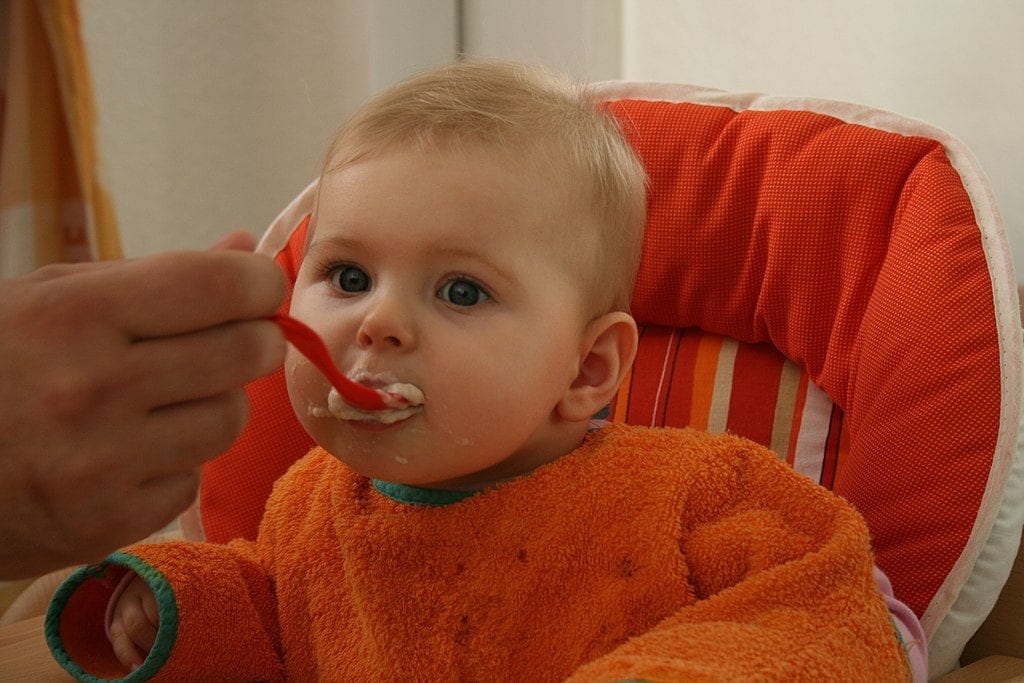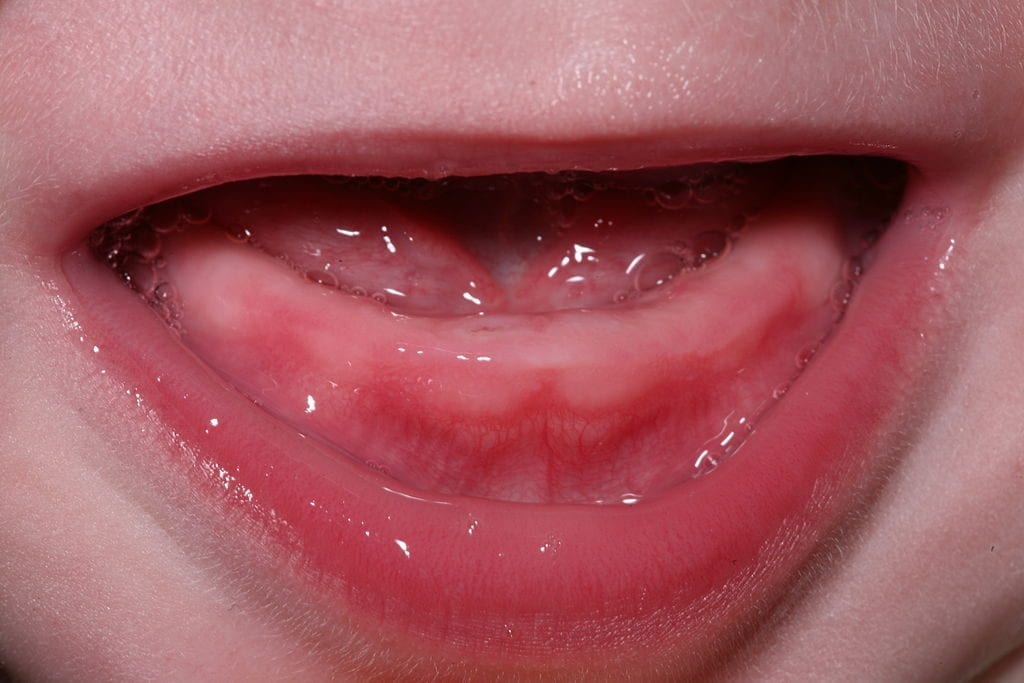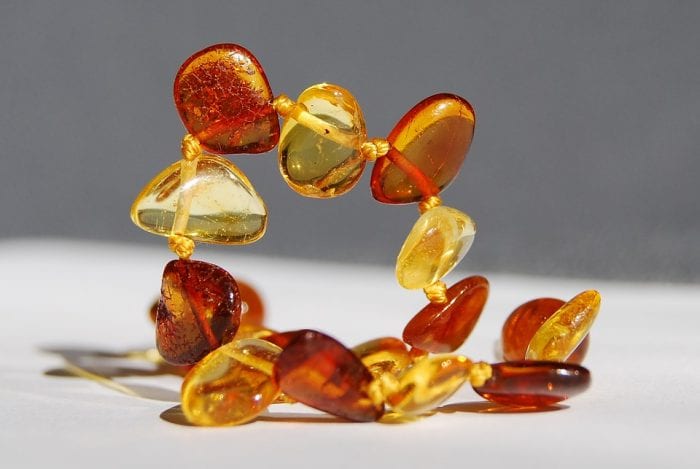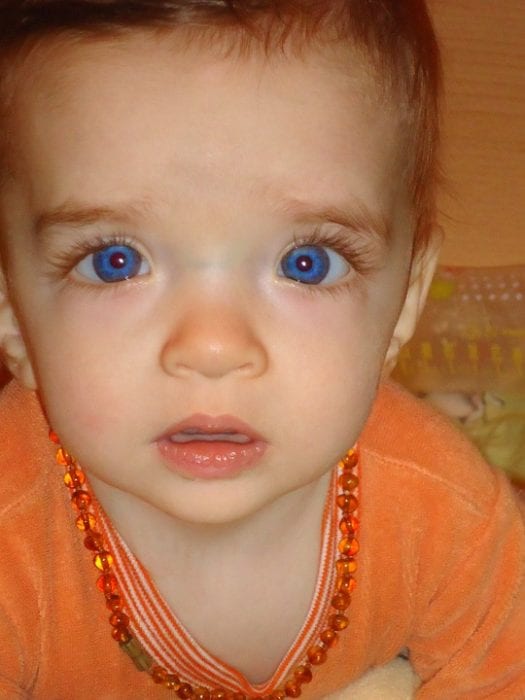As parents, you would always look forward to the time when your baby can start eating real food. Sadly, it is not exactly as exciting both for babies and parents as it appeared before when the pains of teething get in the way. This is why you need an amber necklace!

Teething In Babies
When your baby starts to experience their teeth growing, you will observe their cheeks becoming more red than usual. True enough, all the excitement would begin at the glimpse of your child’s first few sets of teeth. As you look closely, you will notice swelling in the gums because your baby constantly rubs or bites it. This is also accompanied by heavy drooling and irritability. This means fewer hours of sleep for you again at night.
 Source: pucommons.wikimedia.org
Source: pucommons.wikimedia.org
More than just the unsettling feeling of your baby, they also experience sharp pains and extreme body heat because of teething. The tooth buds inside the gums are now growing and pushing up the gums. This makes your baby particularly sensitive.
What Amber Teething Necklace Is
The Amber Teething Necklace is a famous deep brown bead accessory to be used by babies to ease the pain when their teeth start to grow. The amber teething necklace is made of amber, which comes from plants’ fossilized resin or sap, like conifers and angiosperms. Sap comes out of the bark of a tree when it has been cut down. It eventually solidifies into rock over time. This Baltic accessory contains around 8% of succinic acid, which is said to have therapeutic effects. It is one of the oldest gemstones in human history.
 Source: pixabay.com
Source: pixabay.com
How Amber Teething Necklace Works And Its Features
According to advocates of the Baltic amber teething necklaces, the warmth of a baby’s skin releases the natural oils inside it. The natural oils that carry succinic acid are absorbed by the child’s skin. Succinic acid has historically been an anti-inflammatory agent, helping ease pains.
People primarily put these necklaces on babies to address pain when teeth start growing and to relieve their sore gums. When babies start to grow teeth, their gums can become sore and uncomfortable. The idea behind them is that the natural properties when in contact with the baby’s skin, may help alleviate the discomfort associated when teeth is growing.
The necklaces are typically worn around the baby’s neck, with the beads positioned against the skin. The baby’s body heat triggers the release of succinic acid, which is then absorbed into the bloodstream. It is claimed that succinic acid has analgesic and anti-inflammatory properties, which can potentially help soothe the baby’s sore gums.
Most teether necklaces have a screw clasp to secure it around the baby’s neck. This clasp is designed to ensure it remains securely fastened and reduces the risk of the baby removing or accidentally swallowing the beads.
However, it’s important to note that using these necklaces for pain relief when teeth start to grow is a topic of debate, as scientific evidence supporting their effectiveness is limited. Furthermore, the safety concerns related to necklaces worn by babies should be carefully considered, including the potential risk of choking or strangulation. Consultation with a pediatrician is advised before using this or any teething remedy for a baby.
Claimed Benefits Of Baltic Amber Necklaces
It is marketed to relieve pain when teeth start to grow and provide sensory stimulation for babies and young children. According to some sellers, the common belief is that this accessory releases succinic acid, a pain-relieving substance, when the baby’s body temperature is warmed. However, there is no scientific research and evidence to support these claims. The American Academy of Pediatrics (AAP) warns against using them due to the risk of choking, strangulation, and severe injury to babies and young children.
These accessories are also claimed to have other benefits, such as easing joint pain, boosting the immune system, helping with concentration, and treating skin conditions such as acne. There’s evidence that wearing these teether necklaces can relieve symptoms related to menstruation or pregnancy.
While sellers of amer teething necklace claim that it has various benefits, including relieving pain, no scientific evidence supports these claims. It is important to prioritize your child’s safety and follow the recommendations of pediatric societies such as the AAP. Relying solely on anecdotal evidence or unproven claims may put your child at unnecessary risk.
How Amber Teething Necklace Affects Your Baby
It is said to have soothing and calming effects on your baby due to the succinic acid, which is a natural painkiller. Also, this boosts the immune system and helps the treatment of bacterial infection. It helps in the detoxification process of the body and supports the regeneration of bodily tissues.
 Source: flickr.com
Source: flickr.com
Potential Risks And Benefits Of Using These Teethers For Infants
These teether necklaces are marketed to relieve teething discomfort in babies. These necklaces are either polished or raw, a fossilized tree resin. Retailers claim that these beads can relieve teething pain because amber contains succinic acid, and when absorbed by the baby’s body, helps to soothe the pain. However, there is no scientific evidence to support these claims.
There is mounting research that this teether jewelry, including necklaces, is unsafe. The Canadian Paediatric Society (CPS), American Academy of Pediatrics, and FDA warn parents and caregivers not to use these necklaces on babies and toddlers. The risks of using teether necklaces include choking, strangulation, infection, and injury to the mouth or gums.
It is important to note that the AAP recommends using alternative methods for pain relief when teeth are growing, such as chilled teether rings or a clean finger.
What To Remember: Key Points And Takeaways
As mentioned in other baby sites like WhatToExpect, like any other helpful accessory worn by your baby, there are risks associated with these teether necklaces. This means you must closely supervise your baby while using it. First, this is not intended to be chewed on. Chewing on the necklaces potentially weakens it; when it does, you have to throw it right away. It is meant to be worn out to release the succinic acid.
Even as early as two months old, your baby can wear the amber teether necklace to get used to it. However, the crucial part is when your baby is approaching three years old because this is when teeth-growing is at its peak. Place it on your baby at just the right length to ensure it relieves pain, relieves aches, and reduces inflammation. It cannot be too tight to cause suffocation or too long to be strangled upon your baby.
To avoid choking hazards, remove it for babies during nap and sleep times. Besides, your baby will no longer need it when they are asleep. Let your infants wear the bead accessory only when they are awake and under your supervision so it doesn’t become a choking hazard.
Never leave your child unattended as he wears the teether necklaces, as it could block their respiratory system and cause a really tough time. Alternatively, you can choose among other versions of the Baltic amber bead for your baby’s mouth, which also comes in the form of a bracelet and anklet.
 Source: pixabay.com
Source: pixabay.com
It is always best to harness the natural ways to help ease your baby’s pain. The amber teether necklaces provide these natural oils to help your baby. Additionally, they need proper and constant supervision. If the discomfort seems severe, consult your pediatrician about appropriate medicine. They might recommend a mild pain reliever like acetaminophen, especially if your baby has trouble sleeping due to teething pain. However, always use medication as a last resort and according to the prescribed dosage for your baby’s age and weight.
Frequently Answered Questions (FAQs)
Does Amber Teething Necklaces Work And Help With Teething?
These are believed by some to help with teeth-growing pains due to their claimed healing properties. It is important to note that scientific evidence supporting these claims is limited, and the effectiveness of amber teether necklaces for pain relief remains a subject of debate.
The belief is that amber, a gemstone in its natural state, contains succinic acid, which is thought to have analgesic and anti-inflammatory properties. When worn against the skin, the body heat is said to trigger the release of this succinic acid, which then helps alleviate issues by absorbing it into the bloodstream. It is claimed that succinic acid can potentially help soothe discomfort.
However, it is worth mentioning that some beads on the market are heat treated using high temperatures or modified, which can alter their composition and potentially affect the release of succinic acid. The authenticity and quality of the amber beads used can impact their potential effectiveness.
While many parents have reported positive experiences using amber beads, it is essential to approach them with caution and consult with a pediatrician before using them on your teething baby. It is also crucial to ensure the beads are securely fastened with a knot and used under adult supervision to prevent choking or strangulation hazards for teething babies.
Are Amber Teether Necklaces Dangerous?
Unfortunately, amber necklaces can cause injuries or, worse, deaths. That’s especially true if made from fossilized tree resin, plastic, or wood. After all, the FDA and consumer product safety commission both say that this teether jewelry can strangle or choke babies, especially if they keep wearing it in their sleep.
How Quickly Do Amber Teether Necklaces Work?
Please take note: it depends on how long the break will be. Usually, the amber teether necklace takes time for the succinic acid to build up to full effect. It can take about days to 2-3 weeks.
Do They Help With Drooling?
Amber teether necklaces help stimulate the thyroid gland of an infant to control drooling and develop better gnawing skills. It also improves the immune system’s ability to reduce the baby’s ear, throat, stomach, and respiratory inflammation.
At What Age Can A Teething Baby Wear Amber Necklaces?
Amber necklaces can be used until the baby is three years old, but many kids like to wear them long afterward because they are also beautiful.
The FirstCry Parenting website suggests that most parents start giving their babies amber teether necklaces after they turn four months old. Some babies wear them until their 3rd birthday when the teeth-growing process finishes.
It is beneficial if a baby starts wearing it at the age of 2 months. This way, the baby gets accustomed to wearing it at an older age. At that age, they will not get accustomed to biting or tugging at it and wear it as an extension of their body.
How Can You Tell If It Is Genuine Amber?
There are several ways to tell if it is genuine. Here are some methods you can use:
Specific gravity test: Real amber should float in saltwater, not sink.
Scratch test: It crumbles when scratched gently, while fake leaves elastic chips.
Imperfections: Look for imperfections like air bubbles, cracks, or deformed inclusions. Genuine amber is unique and imperfect, while fake is uniform and flawless.
UV light test: Expose it to UV light. Natural amber glows blue, while fake does not.
Heat test: Heat it slightly. Genuine amber produces a pine odor, while fake does not.
You can also tell if it is genuine by its texture and temperature. Natural amber is warm to the touch and has a wax-like shine. Common imitations are casein, celluloid, copal, glass, kauri gum, plastic, and phenolic resin.
How Long Does Amber Necklaces Last?
The lifespan of an amber teether necklace depends on how it is cared for. Usually, it is good for approximately two years. The duration of the necklace’s effectiveness depends on how it is cared for. It can take time for the succinic acid to build up to full effect, which can take anywhere from days to 2-to 3 weeks.
If you take care of your necklace, it can last for several years. You should ensure the chain doesn’t get dirty, stepped on, or damaged. Amber can become brittle and fade over time, especially if exposed to soaps, creams, perfumes, chlorine, or heat. It’s important to regularly wash the necklace and inspect it for any signs of wear or damage to ensure it remains safe for the baby to use.
Can Babies Sleep With Amber Teething Necklaces On?
No, it would be best if you did not leave the amber teether necklace around your child’s neck while they are sleeping. Doing so will jeopardize their safety (read more about it here: https://www.todaysparent.com/baby/teething/amber-teething-necklaces/).
Can A 3-Month-Old Wear An Amber Teething Necklace?
According to some sources, three-month-old babies are usually allowed to wear them. When warmed by body heat, these teether necklaces help with pain by releasing succinic acid, a natural pain reliever.
However, there is no scientific evidence that these teether necklaces work and the FDA warns against using them due to the risk of strangulation and choking. Therefore, it is advisable to consult your pediatrician before using this teether necklace for your baby.
When Can You Put An Amber Necklace On A Baby?
Parents often begin using these teether necklaces when they notice the first signs of teeth-growing issues in their baby, which can vary in age. It is important always to prioritize safety and consult a pediatrician before using any aids. Some sources suggest babies can wear them as young as two months old. It is recommended to start that young to get the baby accustomed to wearing a necklace without biting or tugging at it. They are usually worn until the baby is three years old when the growing of teeth stops.
However, as mentioned before, there is no scientific evidence that amber teether necklaces work and the FDA warns against using them due to the risk of strangulation and choking. Therefore, it is advisable to consult your pediatrician before using this necklace for your baby.
What Is The Most Effective Remedy For Teething?
It can be a painful experience for babies and parents alike. While many remedies are available, it is important to choose one that is safe and effective. According to the Mayo Clinic, medications containing benzocaine or lidocaine can harm your baby. However, other remedies can help soothe your baby’s sore gums. One of the best remedies is gentle gum massage. After washing your hands, use your fingers to carefully rub your baby’s gums with gentle, circular motions.
Another remedy that has gained popularity in recent years is Baltic amber teether necklaces. These necklaces are made of fossilized resin from ancient forests in the Baltic region and are believed to have pain-relieving and anti-inflammatory effects and healing properties. When warmed by the baby’s skin, the necklace is supposed to work by releasing natural oils that contain succinic acid. The succinic acid is then absorbed through the skin and into the bloodstream. However, it is essential to note that no scientific evidence supports these claims.
While Baltic amber necklaces may seem like a natural and safe remedy, they pose a risk of choking, strangulation, mouth injury, and infection. Therefore, using them with caution and under adult supervision is important.
Are Teething Necklaces A Good Idea?
Teether necklaces are not a good idea for babies, as they pose a risk of choking and strangulation. The American Academy of Pediatrics and the Food and Drug Administration do not recommend that infants wear any jewelry. Teether necklaces are also ineffective, as there is no scientific evidence that amber beads release succinic acid or that succinic acid has any anti-inflammatory or pain-relieving properties.
A better alternative for relief is a frozen washcloth. A frozen washcloth can provide a soothing sensation and a gentle massage for a baby’s sore gums. It can also help reduce inflammation and numb the pain. Wet a frozen washcloth, wring it out, and place it in the freezer for about 15 minutes. Then, let your baby chew on it under your supervision.
Many parents also use other natural or homeopathic remedies for teething, such as wooden teethers, silicone teethers, frozen fruits or vegetables, chamomile tea, clove oil, or gentle massage. However, you should consult your pediatrician before trying any new remedy for your baby.
What Are Some Effective And Safe Methods To Help Alleviate My Baby’s Aches And Pains When Teeth Are Growing?
A: A great way to soothe your baby’s ache is by providing them with soft toys designed specifically for teething. These can be worn on the wrist as bracelets or on the ankles for easy access by the baby. Ensure the toys are securely fastened at one end to prevent any risks, and always supervise their use to avoid any discomfort near the ears or other sensitive areas.
Last Updated on April 12, 2023 by Nisa Jabajab
DISCLAIMER (IMPORTANT): This information (including all text, images, audio, or other formats on FamilyHype.com) is not intended to be a substitute for informed professional advice, diagnosis, endorsement or treatment. You should not take any action or avoid taking action without consulting a qualified professional. Always seek the advice of your physician or other qualified health provider with any questions about medical conditions. Do not disregard professional medical advice or delay seeking advice or treatment because of something you have read here a FamilyHype.com.